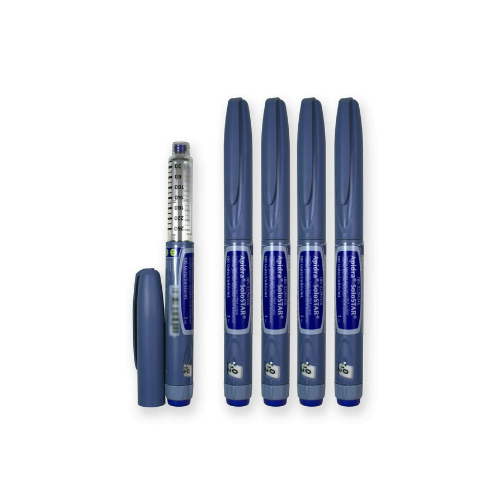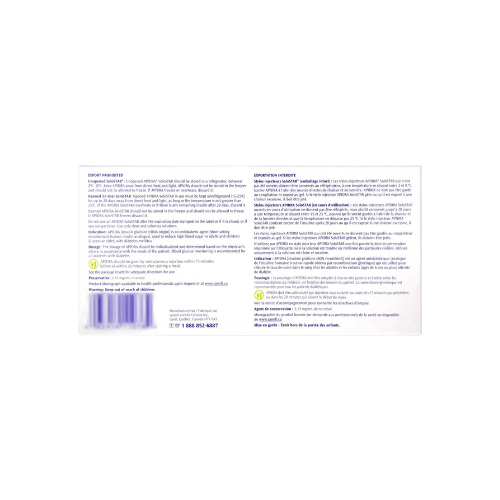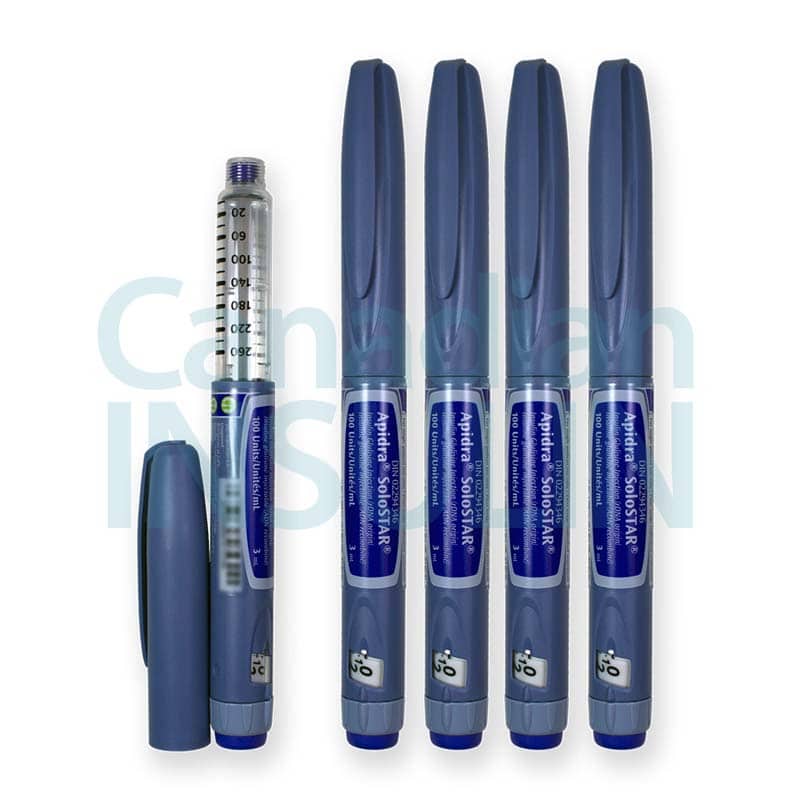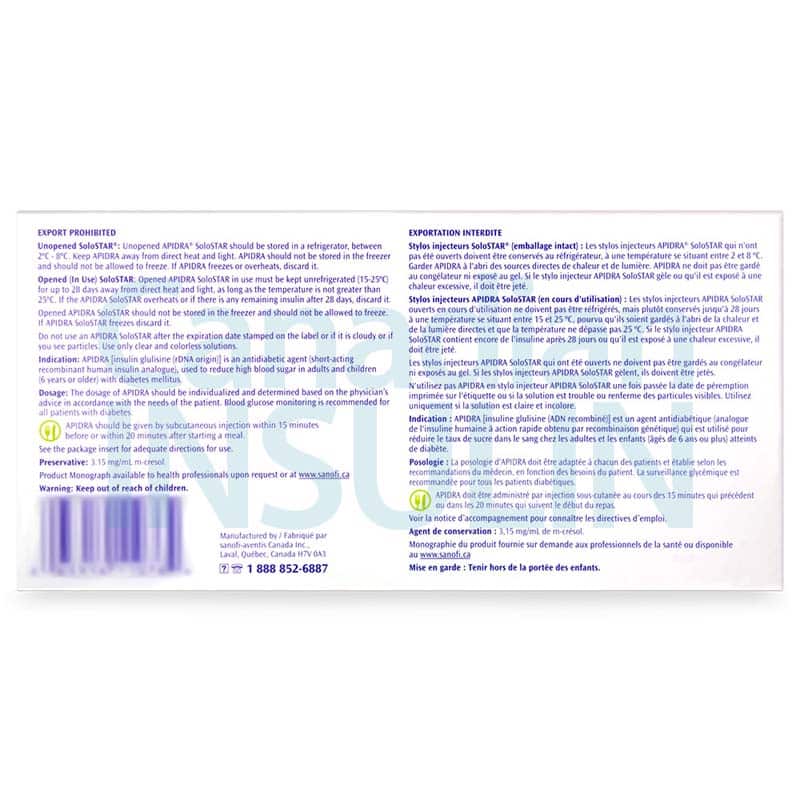Please note: a valid prescription is required for all prescription medication.
Apidra® SoloStar Pens are prefilled, rapid-acting insulin pens used at mealtimes to help control blood sugar in people with diabetes. This page explains how this medicine works, safe pen use, and practical details about access, storage, and handling. You can also review ordering options with US delivery from Canada and considerations if paying without insurance.
What Apidra Is and How It Works
This product contains insulin glulisine, a rapid-acting insulin analog. It starts working quickly to cover carbohydrate intake at meals and to correct high readings. The treatment is usually taken with a long-acting basal insulin as part of a complete regimen. Refer to the prescribing information for full details on indications and use.
CanadianInsulin.com is a prescription referral platform. We verify prescriptions with your prescriber when required, and licensed Canadian pharmacies dispense your order.
Like other rapid-acting insulins, this medicine helps move glucose from the bloodstream into cells. It may be used in adults and children when mealtime coverage is required. For a deeper overview of this class and timing basics, see our guide Understanding Apidra.
Who It’s For
Apidra SoloStar pens for diabetes are used to improve glycemic control in adults and pediatric patients who need mealtime insulin. Your prescriber may select it for type 1 diabetes in combination with basal insulin, or for type 2 diabetes when meals require rapid coverage. If you have had a severe reaction to insulin glulisine or any component of the pen, you should not use this medicine.
People with frequent hypoglycemia, severe kidney or liver problems, or those who cannot recognize low sugar symptoms should discuss risks and alternatives with a clinician. Read more about conditions and treatment approaches in Type 1 Diabetes and Type 2 Diabetes.
Dosage and Usage
Use this insulin at mealtimes as directed by your prescriber. It is typically injected shortly before eating, or soon after the start of a meal if needed. Dose depends on carbohydrate intake, current blood glucose, insulin sensitivity, and overall regimen. Never change your dose without medical guidance.
Administer by subcutaneous injection in the abdomen, thigh, or upper arm. Rotate injection sites within a region to reduce the risk of lipodystrophy and skin changes. Do not use the pen for intravenous administration or in an insulin pump. Do not mix this mealtime insulin with other products in the pen.
Always perform a safety test and prime per the manufacturer’s instructions before each injection. Attach a new needle for every use, keep the cap on when not in use, and confirm a clear, colorless solution before injecting. If you are uncertain about timing or technique, review the official patient instructions that come with the device.
Strengths and Forms
This medicine is supplied as prefilled disposable pens that deliver multiple doses. The solution is insulin glulisine at 100 units/mL in a 3 mL SoloStar device. Packs commonly contain 5 pens. Availability may vary by dispensing pharmacy and by current inventory.
Some patients prefer prefilled devices for convenience. Apidra SoloStar prefilled pens can support fine-tuned dose increments as directed by your clinician. Confirm the dose step and unit scale on your specific pen before use, and review device instructions.
Missed Dose and Timing
If you miss a mealtime dose, check your blood sugar and follow your prescriber’s instructions. You may be advised to take it with the next meal or use a correction dose. Because this class acts quickly, avoid stacking doses too close together unless you have been taught a correction plan.
Do not double your dose to make up for a missed injection. If you are unsure what to do, monitor closely and seek professional advice. Keep fast-acting carbohydrates available to treat low blood sugar if it occurs.
Storage and Travel Basics
Unopened pens are typically stored in a refrigerator. Do not freeze. Keep away from heat and light. Once a pen is in use, store as directed on the label, usually at room temperature, and discard after the recommended in-use period. Keep out of reach of children and pets.
When traveling, carry your insulin and supplies in a separate hand bag. Keep a spare pen, extra needles, a glucose meter or CGM supplies, and a source of fast sugar. Bring a copy of your prescription and a medication list. If you use a cooler pack, make sure the pen does not touch ice or a freezer pack directly.
For more tips on pen use and timing expectations, see SoloStar Pen Features and our category page for Rapid-Acting Insulin.
Pen Handling and Sharps Disposal
Wash your hands. Remove the cap, attach a new needle, and prime per instructions. Select the prescribed dose. Inject into the recommended subcutaneous areas and hold for the time noted in the device guide. Detach and discard the needle into an approved sharps container after each use.
Never share your pen or needles with anyone, even if the needle has been changed. Sharing may spread infections. Do not reuse needles. Follow local rules for sharps disposal. Many communities offer pharmacy-based or municipal take-back programs.
Benefits
This mealtime insulin acts quickly to match food intake and can help lower post-meal spikes. It pairs with basal insulin to complete a regimen for many people. The pen format may simplify dosing for people who prefer a discreet, portable device.
Some patients prefer flexible timing that this class can offer around meals. Apidra SoloStar mealtime insulin pens may support dose adjustments with carbohydrate counting or correction scales when directed by a clinician. For background on how rapid insulins compare, explore Insulin Types Guide.
Side Effects and Safety
- Low blood sugar: shakiness, sweating, fast heartbeat, hunger, headache
- Injection site reactions: redness, itching, swelling
- Lipodystrophy or skin thickening at injection sites
- Weight gain or mild edema
Serious reactions can include severe hypoglycemia, low potassium, or a severe allergic response. Thiazolidinediones used with insulin can cause or worsen fluid retention and may lead to heart failure in susceptible patients. Seek medical attention for symptoms of severe low blood sugar, widespread rash, trouble breathing, or chest discomfort.
Drug Interactions and Cautions
Medicines that may increase the insulin effect include alcohol, ACE inhibitors, ARBs, sulfonamides, and certain antidepressants. Agents that may decrease the effect include corticosteroids, some diuretics, and sympathomimetics. Beta blockers may mask the warning signs of low blood sugar.
Use caution with potassium-lowering drugs, because insulin can reduce potassium levels. If you start or stop any medication, monitor glucose more frequently. Discuss heart failure risk when combining insulin with thiazolidinediones. For broader therapy context, review our category for Diabetes Medications.
What to Expect Over Time
With regular use at meals and appropriate monitoring, you may see smoother post-meal readings. Many people work with a clinician to refine dose timing around food and activity. Keep a record of readings and doses to support adjustments at routine visits.
Consistent injection technique and site rotation can help reduce local skin changes. Keep fast-acting carbohydrates at hand, and educate close contacts on recognizing low blood sugar. If you experience frequent highs or lows, contact your prescriber to reassess your plan.
Compare With Alternatives
Other rapid-acting options may be considered if this pen is not suitable or not available. For example, Humalog® KwikPen offers comparable mealtime coverage in a prefilled device. Another option is Fiasp® FlexTouch, an insulin aspart formulation designed for rapid onset.
To understand practical differences that may matter to you, see our overview Apidra vs Humalog. For naming and substitution context, read Apidra Generic Name.
Pricing and Access
The Apidra SoloStar pens price varies by pack size, dispensing pharmacy, and market conditions. We list current options so you can compare and discuss with your prescriber. If you prefer to order Apidra SoloStar pens online, you can proceed after your prescription is verified. Ships from Canada to US for eligible orders.
Many patients compare Canadian pricing to potential local options to find value, especially when paying cash. If you are looking for a coupon or seasonal offer, check our Promotions page. Some patients ask about best price Apidra SoloStar pens; availability and total out-of-pocket cost depend on your prescription, pack size, and dispensing pharmacy policies. When paying without insurance, consider multi-pack fills if approved by your clinician.
Availability and Substitutions
Stock can change. If a specific presentation is unavailable, your prescriber may recommend another rapid-acting insulin in a comparable device. We do not guarantee restock dates. A valid prescription is required, and product selection should follow your clinician’s guidance.
Patient Suitability and Cost-Saving Tips
This treatment may suit people who need flexible mealtime coverage, use carbohydrate counting, or require small dose adjustments. Those with frequent severe lows, significant injection site issues, or allergies to components should discuss alternatives. Pediatric use should follow label directions and clinician oversight.
To manage expenses, ask your prescriber about multi-month fills. Set refill reminders so you do not run out unexpectedly. Consider comparing options within the Diabetes category, and review class pages like Rapid-Acting Insulin for related choices.
Questions to Ask Your Clinician
- Meal timing: how soon before or after eating should I inject?
- Dose method: should I use a carb ratio and correction scale?
- Low sugar plan: how do I treat hypoglycemia at home or work?
- Site rotation: which areas are best for me, and how to rotate?
- Travel: how should I store pens in hot or cold weather?
- Transitions: what if I switch from another rapid insulin?
- Concomitant therapy: how does my basal insulin fit with this?
Authoritative Sources
For the full prescribing information and patient instructions, consult the manufacturer’s documents on the official site or in the package insert. FDA DailyMed provides detailed label text and safety information for insulin glulisine. Health Canada’s Drug Product Database lists approved products and formulations.
- FDA DailyMed: official labeling repository for prescription drugs
- Sanofi: manufacturer site with product and safety information
- Health Canada DPD: approved drug listings and monographs
Medical disclaimer: This content is for informational purposes only and is not a substitute for professional medical advice.
Ready to proceed? You can place your order with prompt, express, cold-chain shipping once your prescription is verified.
Express Shipping - from $25.00
Shipping with this method takes 3-5 days
Prices:
- Dry-Packed Products $25.00
- Cold-Packed Products $35.00
Standard Shipping - $15.00
Shipping with this method takes 5-10 days
Prices:
- Dry-Packed Products $15.00
- Not available for Cold-Packed products
How soon before a meal should I use the pen?
This rapid-acting insulin is generally taken shortly before eating or soon after starting a meal. Follow the timing instructions from your prescriber and the device guide.
Can I mix this insulin with other insulin in the pen?
No. Do not mix other insulin products in the prefilled pen. If your clinician prescribes mixing with NPH, that is typically done with separate vials and syringes, not in a prefilled device.
How many units are in each pen?
Each SoloStar pen contains 3 mL of solution at 100 units per mL. Total units per pen are listed on the carton and device, and vary only by labeled concentration.
What if my blood sugar is low before a meal?
Treat the low first per your care plan, then reassess your meal and dose with your clinician’s guidance. Do not inject while hypoglycemic unless directed by a professional.
Do I need to prime the pen every time?
Yes. Perform a safety test and prime before each injection to ensure proper insulin flow and dose accuracy, as described in the device instructions.
How should I store the pens during travel?
Keep unopened pens cool and protected from heat. Do not freeze. Carry them in hand luggage with spare needles, a prescription copy, and a plan to avoid direct contact with ice packs.
Can children use this insulin?
The product is indicated for pediatric patients when mealtime insulin is appropriate. Dosing and monitoring must follow the label and the child’s clinician’s instructions.
Rewards Program
Earn points on birthdays, product orders, reviews, friend referrals, and more! Enjoy your medication at unparalleled discounts while reaping rewards for every step you take with us.
You can read more about rewards here.
POINT VALUE
How to earn points
- 1Create an account and start earning.
- 2Earn points every time you shop or perform certain actions.
- 3Redeem points for exclusive discounts.
You Might Also Like
Related Articles
Zepbound storage: Keep It Safe With Clear Temperature Rules
This guide explains Zepbound storage so your medication stays effective. You will learn temperature limits, how long doses can stay unrefrigerated, travel practices, and what to do if a pen…
Zepbound and Fatigue: Practical Tips to Ease Tiredness Safely
Feeling drained after starting tirzepatide can be unsettling. Many users describe a mix of low energy, mild aches, and disrupted sleep early on. If you are navigating Zepbound and fatigue,…
Mounjaro Heart Benefits Beyond Weight Loss: Evidence-Based Guide
Interest has grown around Mounjaro heart benefits as clinicians evaluate tirzepatide’s broader impact beyond glucose control and weight. Patients want clear, cautious guidance. This overview explains what current data suggests,…
Ozempic Rebound: A Practical Guide to Prevent Weight Regain
Many people stop GLP-1 therapy and wonder what comes next. Appetite changes, routine shifts, and metabolism can collide. A clear plan helps you keep progress steady and predictable, not reactive.…










